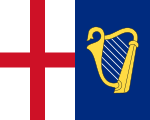General at sea facts for kids
Quick facts for kids General at Sea |
|
|---|---|

Flag of the General at Sea
|
|
| Country | |
| Service branch | Parliamentary Navy |
| Equivalent ranks | Admiral |
The General at Sea was a very important job in the English navy a long time ago. It was the highest position of command in the English Parliamentary Navy. This was the navy during a special time in England's history. You can think of it like the rank of an Admiral today.
These generals were also part of a group called the Commissioners for the Admiralty and Navy. This group helped manage the navy. People sometimes called them 'general' or used their old army ranks. Today, some people incorrectly call them 'admiral'.
Contents
Who Were the Generals at Sea?
In February 1649, King Charles I was executed. After this, the Council of State decided to change how the navy was run. They put the job of Lord High Admiral on hold.
Instead, Parliament chose three army officers to lead the navy. These were Colonel Robert Blake, Colonel Edward Popham, and Colonel Richard Deane. They became the first Generals at Sea. They also served as Commissioners for the Admiralty and Navy.
Changes in Leadership
In 1651, Edward Popham passed away. General George Monck took his place in 1652. Richard Deane was called back to the army for a short time in May 1651. He returned to his navy role in 1652. Sadly, he was killed at the start of the Battle of the Gabbard in June 1653.
After Deane's death, Blake and Monck continued to serve alone. Then, in December 1653, Parliament decided to have four Generals at Sea. They added Major-General John Desborow and Vice-Admiral William Penn.
A Sailor Becomes a General
William Penn was special because he was the first sailor to become a General at Sea. Before him, only soldiers were chosen for this top navy job. Monck had recommended Penn for the role. All four men also served as Commissioners for the Admiralty and Navy. They worked with other important people like Colonel Philip Jones.
William Penn's Journey
Penn's navy career faced a challenge in 1655. He was involved in a plan called the Western Design. This plan to attack Spanish colonies in the West Indies did not go well. Because of this, Penn was put in the Tower of London for a short time. He had to leave his navy job.
However, he must have been called back later. In 1658, the Dutch Ambassador said Penn was in charge of a fleet. During a time of political trouble, Penn left the navy to help keep order. He became a Member of Parliament for Weymouth in 1660.
Despite his past under Cromwell, Penn was chosen for a very important task. Parliament asked him to welcome King Charles II back to England. The King was returning from exile. On May 23, the King knighted Penn. The ship they were on was renamed from Naseby to Charles.
Penn then became a commissioner for the navy. He worked with Samuel Pepys on the Navy Board. Penn was a very skilled naval commander. He even created new rules for naval tactics. Pepys, who wrote a famous diary, recognized Penn's great skill.
Later Generals
In January 1656, Edward Montague was appointed General at Sea. Robert Blake continued to serve until he died at sea in August 1657. Edward Montagu served until 1665.
Gallery
Rank Insignia and Personal Flag
Red Squadron Flag
Generals at Sea in command of the red squadron used these flags:
White Squadron Flag
Generals at Sea in command of the white squadron used these flags:
Blue Squadron Flag
Generals at Sea in command of the blue squadron used these flags:











